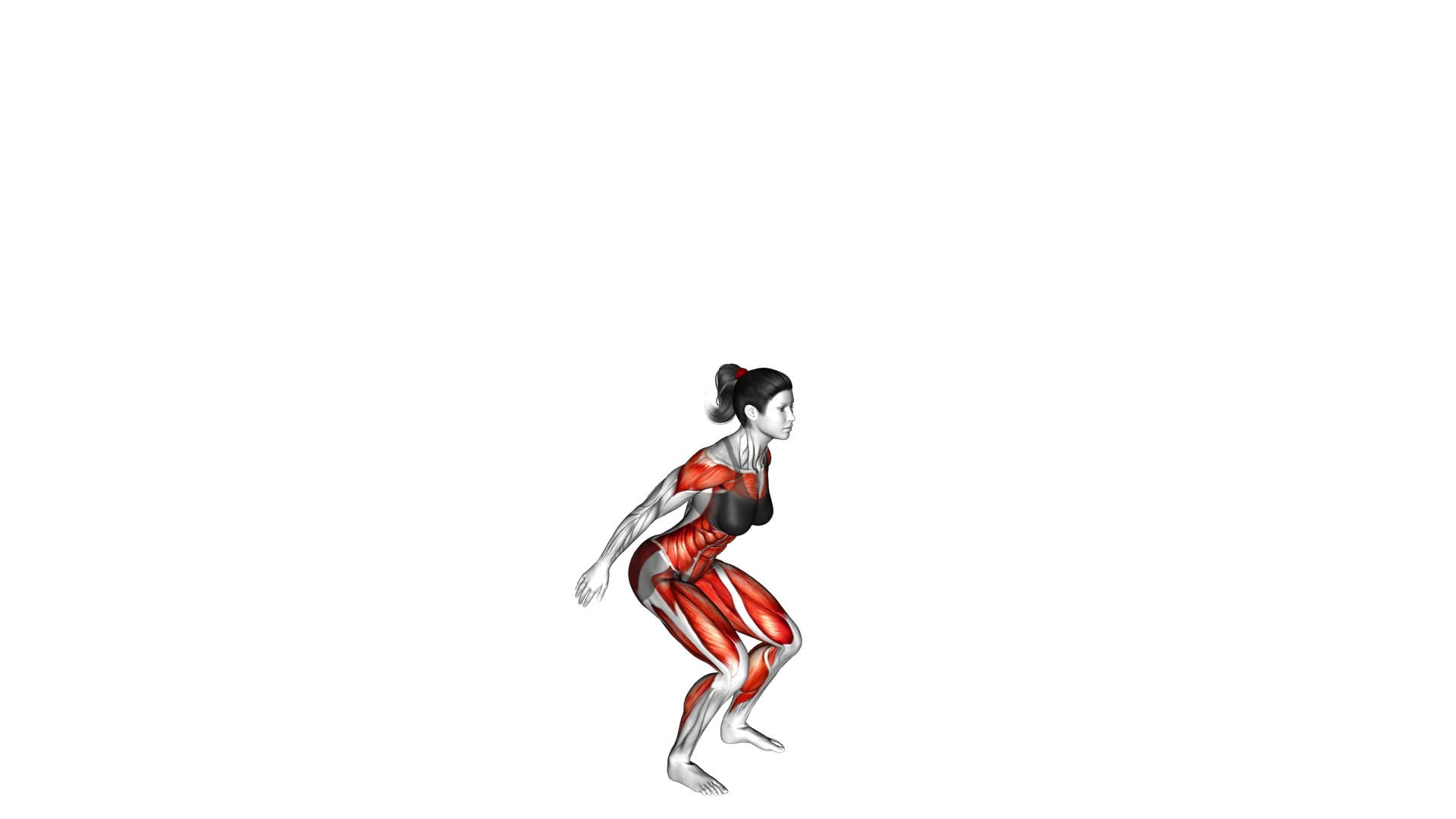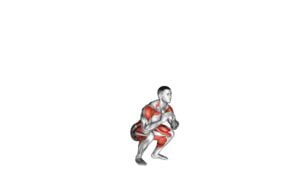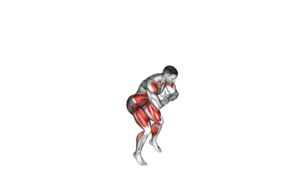Squat Tuck Jump (female) – Video Exercise Guide & Tips

Are you looking for a high-intensity exercise that targets multiple muscle groups? Look no further than the squat tuck jump! This explosive move not only strengthens your legs and glutes but also improves your cardiovascular endurance.
Watch This Exercise Video
In this video exercise guide, we'll show you how to perform the squat tuck jump with proper form and technique. Whether you're a beginner or an advanced athlete, we've got modifications and variations to suit your fitness level.
Get ready to take your workout to the next level!
Key Takeaways
- Squat tuck jumps target multiple muscle groups and improve cardiovascular endurance.
- They strengthen the legs, glutes, and activate core muscles.
- Squat tuck jumps enhance stability, balance, and explosive power.
- They also boost cardiovascular fitness and are beneficial for athletes requiring quick bursts of energy.
Benefits of Squat Tuck Jump
Experience three key benefits when incorporating squat tuck jumps into your workout routine.
Plyometric exercises like squat tuck jumps are a great way to improve your explosive power and overall athletic performance. First and foremost, these exercises target multiple muscle groups, making them highly efficient for building strength and endurance. Squat tuck jumps engage your quads, glutes, hamstrings, and calves, helping you develop stronger and more toned legs. Additionally, these jumps also activate your core muscles, enhancing stability and balance.
Secondly, incorporating squat tuck jumps into your routine can significantly boost your cardiovascular fitness. The explosive nature of the exercise requires a rapid increase in heart rate, leading to improved cardiovascular endurance and a stronger heart. This can be especially beneficial for athletes participating in sports that require quick bursts of energy, such as basketball or soccer.
Finally, squat tuck jumps can help enhance your overall power and explosiveness. By repeatedly performing this plyometric exercise, your muscles learn to generate force quickly, leading to improved speed and agility. This can translate into better performance in activities that require explosive movements, such as sprinting or jumping.
Incorporating squat tuck jumps into your workout routine can provide you with the benefits of targeting multiple muscle groups, improving cardiovascular fitness, and enhancing power and explosiveness. So why not add this effective exercise to your fitness regimen and take your training to the next level?
How to Perform Squat Tuck Jump
To perform a squat tuck jump, follow these steps to engage multiple muscle groups and improve your explosive power:
- Start by standing with your feet hip-width apart, toes pointing forward.
- Lower your body into a squat position by bending your knees and pushing your hips back, keeping your chest lifted and core engaged.
- From the squat position, explode upward, pushing through your feet and extending your legs and hips. As you jump, tuck your knees up towards your chest, bringing them as close as possible.
- Land softly back into the squat position, absorbing the impact with bent knees to protect your joints.
To progress with the squat tuck jump, you can try the following options:
- Increase the height of your jump by jumping onto a platform or step.
- Add weights to increase the resistance and challenge your muscles further.
- Perform the exercise at a faster tempo to improve your explosiveness.
- Combine the squat tuck jump with other plyometric exercises to create a more challenging workout.
Remember these safety tips when performing the squat tuck jump:
- Warm up properly before attempting the exercise to prepare your muscles and joints.
- Start with a lower intensity or modified version if you're a beginner.
- Maintain proper form throughout the movement to prevent injuries.
- Listen to your body and stop if you experience any pain or discomfort.
Common Mistakes to Avoid
While performing the squat tuck jump, it's important to be aware of common mistakes to avoid in order to maximize the effectiveness and safety of the exercise. One common mistake isn't maintaining proper form throughout the movement. It's crucial to start with a squat position, keeping your feet shoulder-width apart and your knees tracking over your toes.
As you jump up, make sure to keep your core engaged and your back straight. Another mistake to avoid isn't fully extending your hips and knees at the top of the jump. This can lead to a less effective workout and increase the risk of injury.
Additionally, be cautious of landing with your knees locked or landing too heavily, as this can strain your joints. Instead, aim to land softly with a slight bend in your knees to absorb the impact.
Modifications for Beginners
If you're new to the squat tuck jump exercise, there are several modifications you can make to make it easier.
One option is to perform a regular squat without the tuck jump.
Another modification is to perform a smaller jump instead of tucking your knees to your chest.
Additionally, it's important to prioritize safety by starting with a lower intensity and gradually increasing the difficulty as you build strength and confidence.
Easier Modifications for Beginners
Try the modified version of the Squat Tuck Jump to make it easier for beginners. Here are some easier modifications and beginner safety precautions to keep in mind:
- Begin with a regular squat jump: Start by performing a regular squat jump without incorporating the tuck jump. This will help you build strength and improve your jumping ability.
- Use a lower intensity: Instead of jumping as high as possible, focus on a smaller jump and gradually increase the intensity as you become more comfortable and confident.
- Modify the tuck jump: Instead of tucking your knees up towards your chest, simply lift them to a comfortable height. This reduces the impact on your joints and makes the exercise more manageable.
- Land softly: When landing from the jump, be sure to land softly with your knees slightly bent to absorb the impact and protect your joints.
Progression Options for Beginners
To continue progressing as a beginner, incorporate these modification options into your Squat Tuck Jump routine.
As a beginner, it's important to prioritize safety and gradually increase the intensity of your workouts.
One modification option is to perform a modified squat jump instead of the full tuck jump. Start by bending your knees into a squat position and then jump straight up, extending your arms.
Another modification option is to perform a squat jump without the tuck. This involves squatting down, jumping straight up, and landing back into the squat position.
Remember to listen to your body and only progress to the full tuck jump when you feel comfortable and confident in your abilities. Always warm up properly and follow safety precautions to prevent injury.
Safety Tips for Beginners
To ensure your safety as a beginner, incorporate these modification options into your Squat Tuck Jump routine:
- Start with a regular squat jump: Instead of tucking your knees in, focus on mastering the basic squat jump first. This will help you build strength and stability before progressing to the tuck jump.
- Use a lower jump height: Begin with a lower jump height to reduce the impact on your joints and minimize the risk of injury.
- Land softly: Make sure to land softly on the balls of your feet with bent knees to absorb the impact and protect your joints.
- Warm up properly: Before attempting the Squat Tuck Jump, it's essential to warm up your muscles and joints. Incorporate dynamic stretches and light cardio exercises to prepare your body for the workout.
Advanced Variations to Challenge Yourself
To challenge yourself further, consider incorporating advanced variations of the Squat Tuck Jump into your workout routine. These advanced modifications can help you take your fitness to the next level and improve your strength, power, and explosiveness. However, it's important to remember that safety should always be a top priority when attempting these advanced variations.
Before attempting any advanced variations, make sure you have a solid foundation of strength and stability. It's also recommended to consult with a qualified fitness professional to ensure you're performing the exercises correctly and safely.
One advanced variation of the Squat Tuck Jump is the Plyometric Squat Tuck Jump. This variation involves performing the squat tuck jump with added intensity by exploding off the ground as high as possible and bringing your knees up towards your chest in a tuck position. This exercise requires a strong core and lower body strength, as well as coordination and control.
Another advanced variation is the Single Leg Squat Tuck Jump. This variation involves performing the squat tuck jump on one leg, which increases the demand on your lower body muscles and challenges your balance and stability.
Tips for Incorporating Squat Tuck Jump Into Your Workout Routine
To effectively incorporate the squat tuck jump into your workout routine, it's important to understand its benefits, modifications for beginners, and proper form and technique.
Plyometric training, which includes exercises like the squat tuck jump, can help improve power, agility, and explosiveness.
Beginners can start by performing modified versions of the exercise and gradually increase the intensity as they get stronger.
Remember to maintain proper form throughout the movement to maximize the effectiveness and reduce the risk of injury.
Benefits of Plyometric Training
Incorporate the Squat Tuck Jump into your workout routine to reap the benefits of plyometric training. Plyometric exercises, also known as explosive power training, involve quick, explosive movements that help improve athletic performance and power.
Here are some key benefits of plyometric training:
- Increased explosive power: Plyometric exercises like the Squat Tuck Jump help improve your ability to generate force quickly, resulting in increased power and speed.
- Improved muscular strength: The explosive nature of plyometric exercises engages multiple muscle groups, leading to improved overall strength.
- Enhanced athletic performance: Plyometric training can improve your performance in sports that require explosive movements, such as basketball, sprinting, and jumping.
- Increased calorie burn: The high-intensity nature of plyometric exercises helps burn more calories in a shorter amount of time, making it an effective tool for weight loss.
Modifications for Beginners
As you begin incorporating the Squat Tuck Jump into your workout routine, it's important to consider modifications for beginners to ensure proper form and prevent injury.
If you're new to this exercise, there are modified variations that can help you build strength and coordination before attempting the full movement.
One modification is to perform a regular squat, focusing on lowering down and exploding up with power.
Another option is to do a modified tuck jump, where you jump up while bringing your knees towards your chest, but without the tuck motion. This helps you get used to the explosive jump without the added complexity.
Gradually, as you build strength and confidence, you can progress to the full Squat Tuck Jump.
Remember to always listen to your body and start with modifications that suit your fitness level.
Proper Form and Technique
Start by mastering the proper form and technique for the Squat Tuck Jump. This explosive exercise can provide numerous benefits to your workout routine. Here are some tips to help you incorporate it effectively:
- Begin in a standing position with your feet shoulder-width apart.
- Lower into a deep squat position, keeping your knees in line with your toes.
- Engage your core and jump explosively, bringing your knees up towards your chest.
- Extend your arms forward for balance and control.
By mastering the proper form and technique, you can maximize the benefits of the Squat Tuck Jump. This exercise targets multiple muscle groups, including the quadriceps, hamstrings, glutes, and core. It also improves explosive power and cardiovascular fitness.
Remember to start with modifications if you're a beginner and gradually increase the intensity as you become more comfortable with the exercise.
Frequently Asked Questions
Can Squat Tuck Jumps Help Me Lose Weight?
Squat tuck jumps can be an effective exercise for weight loss. By incorporating proper form and technique, you can maximize the calorie burn and engage multiple muscle groups.
Adding squat tuck jumps to a high intensity interval training (HIIT) workout routine can further enhance weight loss efforts. This dynamic exercise not only increases your heart rate but also boosts your metabolism.
Remember to consult a fitness professional to ensure you perform squat tuck jumps correctly and safely.
What Muscles Are Targeted During a Squat Tuck Jump?
During a squat tuck jump, multiple muscles are targeted. The quadriceps, hamstrings, and glutes are heavily engaged as you lower into the squat and explode upwards into the jump.
Additionally, the calf muscles and core are activated during the tuck phase of the jump.
Incorporating squat tuck jumps into your workout routine can provide numerous benefits, such as improving lower body strength, power, and explosiveness.
To maximize these benefits, it's important to maintain proper form and technique.
How Many Calories Can I Burn by Doing Squat Tuck Jumps?
You can burn a significant number of calories by doing squat tuck jumps. This exercise engages multiple muscle groups, such as the quadriceps, glutes, and calves, which increases your calorie burning potential. The explosive movement involved in squat tuck jumps also boosts your heart rate, leading to increased calorie expenditure.
Additionally, you can vary the intensity of this exercise by modifying the depth of your squat or adding weights. These variations can further enhance the calorie burning benefits of squat tuck jumps.
Are Squat Tuck Jumps Suitable for People With Knee Problems?
If you have knee problems, you may want to consider modifying or finding alternative exercises to squat tuck jumps. While they can be a challenging and effective exercise, they can put strain on your knees.
It's important to prioritize your safety and listen to your body. Speak with a fitness professional who can provide suitable modifications or alternative exercises that will still allow you to work your lower body without exacerbating your knee issues.
Can Squat Tuck Jumps Improve My Vertical Jump Height?
Squat tuck jumps can definitely improve your vertical jump height. By incorporating this exercise into your plyometric workout routine, you can develop explosive power in your lower body.
Proper form is important to prevent injury, so be sure to maintain a squat position and tuck your knees towards your chest as you jump. Common mistakes include using improper form and not fully engaging the core muscles.
Practice consistently and gradually increase intensity for optimal results.
Conclusion
Incorporating the squat tuck jump into your workout routine can be a great way to challenge yourself and improve your overall fitness. This exercise offers numerous benefits, including increased leg strength, improved explosiveness, and enhanced cardiovascular endurance.
By following the proper technique and avoiding common mistakes, you can maximize the effectiveness of this exercise. Whether you're a beginner or advanced, there are modifications and variations available to suit your fitness level.
So why not give the squat tuck jump a try and elevate your fitness game?

Author
Years ago, the spark of my life’s passion ignited in my mind the moment I stepped into the local gym for the first time. The inaugural bead of perspiration, the initial endeavor, the very first surge of endorphins, and a sense of pride that washed over me post-workout marked the beginning of my deep-seated interest in strength sports, fitness, and sports nutrition. This very curiosity blossomed rapidly into a profound fascination, propelling me to earn a Master’s degree in Physical Education from the Academy of Physical Education in Krakow, followed by a Sports Manager diploma from the Jagiellonian University. My journey of growth led me to gain more specialized qualifications, such as being a certified personal trainer with a focus on sports dietetics, a lifeguard, and an instructor for wellness and corrective gymnastics. Theoretical knowledge paired seamlessly with practical experience, reinforcing my belief that the transformation of individuals under my guidance was also a reflection of my personal growth. This belief holds true even today. Each day, I strive to push the boundaries and explore new realms. These realms gently elevate me to greater heights. The unique combination of passion for my field and the continuous quest for growth fuels my drive to break new ground.







